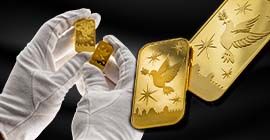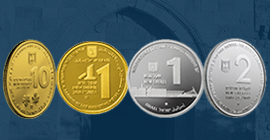Autumn
Silver 999, 38.7 mm, 1 oz.
SKU
21871390
متوفر
$209.00
المواصفات
| سنة الاصدار | 2012 |
|---|---|
| معدن | فضة |
| درجة النقاء | 999 |
| وزن | 1 oz. |
| قطر | 38.7 mm |
| الحد الأقصى لسك العملة | 888 |
| تصميم | Meir Eshel |
"AUTUMN" MOSAIC FROM HAMAT TIBERIAS
4TH MEDAL IN THE "ANCIENT MOSAICS IN THE HOLY LAND" SERIES
Hamat Tiberias is an ancient Jewish settlement, located on the western shore of the Sea of Galilee, where remains dating from the Hellenistic period (2nd century BCE) and later, have been discovered. The name of the settlement is derived from its 17 hot springs, known as Hamei Tiberias, and its proximity to Tiberias, the city that was established to its north by Herod Antipas, son of Herod the Great, in the year 20 CE.
In Roman and Byzantine times (the Mishnaic and Talmudic period), a Jewish community flourished at Hamat Tiberias and famous Jewish Sages (known as the Tanaim and Amoraim, teachers of the Oral Law) were active there. Archeologists have uncovered remains of Synagogues dating from this period, north of Hamei Tiberias and in Tiberias. According to Jewish tradition, there were 13 Synagogues in Tiberias (Babylonian Talmud).
In 1921, while paving a road, remains of a Synagogue at Hamat Tiberias were discovered. Researchers believe that the construction had been destroyed twice and rebuilt for a third time in the 4th century. It was known as the Severus Synagogue, named after one of its founders who had close connections with the President of the Sanhedrin in Tiberias. In the center of the building was an impressive mosaic floor, at the head of which were two seven-branched candelabra (Menorahs), a lulav (palm branch), Shofar and some more Jewish symbols, as well as a depiction of an ark covered with a curtain, which was possibly an artistic representation of the Holy Ark which stood at the front of the Synagogue. In the border of the mosaic was the word "Shalom" in Hebrew, while the dedications were written in Greek and Aramaic. The central inscription included the names of the donors and the builders, and especially Severus. The names and language of the inscription denote the culture of the Jews of the Galilee of the time and their use of the Greek language, which was a prevailing language in the world. The Zodiac Wheel depicted on the mosaic, in the center of which was the sun god Helios from Greek mythology riding a chariot, was less of a Jewish symbol. Judaism refrains from the formation of graven images and, so much more so, of images of a pagan nature, especially when they are to appear on the floor of a Synagogue. It would appear that the people related purely to the aesthetic artistic value of the pagan motifs and not to any religious aspect. Since the area was under Christian influence, it can also be understood that the Roman and Hellenistic gods no longer had any religious significance. The Synagogue in Hamat Tiberias is no exception and similar Zodiac Wheels have been found in other Synagogues in Beit Alpha, Tsipori and other places.
Around the Zodiac signs that represent the months of the year, four feminine figures represent the seasons of the year, in Hebrew: The Hebrew months of Tishrei, Cheshvan and Kislev, correspond to autumn, the months of Nisan, Iyar, Sivan, to Spring, the months of Tammuz, Av and Elul, to summer, and another season, of which the name has not been preserved (probably the months of Teveth, Shevat and Adar – winter). These periods of the year are referred to in Jewish tradition with their religious implications.
The feminine figures on the mosaic are graceful and charming and the artist even made sure to add color to their faces to give them rosy cheeks. They wear chains around their necks and their heads are graced with wreaths of flowers that grow in the respective season. Each of the figures bears objects that characterize the respective agricultural season that she represents. The figure representing the "Tishrei period" (autumn) aappears on the medal. She holds a bunch of grapes, since this season is the time of the grape harvest and wine production. The "Teveth lady" (winter) has a head-cover and is clothed up to her neck, reflecting the cold weather. Part of the mosaic where she appears has been destroyed, but on the part that has survived is a jug full of water, probably alluding to the welcomed rains of the season. The "Nisan lady" holds a large plate full of food, symbolizing the abundant agricultural produce of spring. Next to her head is a flowering plant in bud, characteristic of the springtime. The "Tammuz lady" holds a sickle and next to her head are ears of barley. During the summer period, wheat harvesting is the main agricultural activity.
The Synagogue with this mosaic floor dates from the 5th century and it had been restored four times and again destroyed, at the beginning of the 7th century, the end of the Byzantine period. In the first Islamic period, the Synagogue was restored, attesting to the fact that there was a continued Jewish presence in the area. (The nearby city of Tiberias also proves this). In the 8th century, the Synagogue was destroyed again and not rebuilt.
The site of the Synagogue is near the tomb of the Tanna (teacher of the oral law) Rabbi Meir Ba'al Haness (who studied and taught in the region) and today, it is one of the Israel Nature and Parks Authority's National Parks, open to visitors.
Reverse: Inscription "Ancient Mosaics of the Holy Land" in Hebrew and English, the metal weight and fineness and the Holy Land Mint Logo (the international logo of ICMC).
Edge: Smooth with serial number.
Designer: Meir Eshel.
Engraving: Switzerland.
Mint: Switzerland.
اسم الاصدار: فصل الخريف - الفسيفساء القديمة
اسم السلسلة: فسيفساء قديمة في اسرائيل
| رقم الكتلوج | tbl_condition | قطر | سعر الاصدار | سنة الاصدار | معدن | كمية | وزن |
|---|---|---|---|---|---|---|---|
| 31871390 | 38.7 mm | Unavailable Info | 2013 | Gold 9999 | 360 | 1 oz. | |
| 21871390 | 38.7 mm | 554 NIS | 2012 | Silver 999 | 888 | 1 oz. |

























